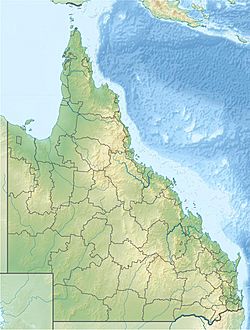Grassy Hill Light facts for kids
 |
|
| Grassy Hill Light, 2005 | |
|
|
|
| Location | Cooktown Queensland Australia |
|---|---|
| Coordinates | 15°27′39.00″S 145°15′19.1″E / 15.4608333°S 145.255306°E |
| Year first lit | 1886 |
| Automated | 1927 |
| Foundation | concrete tower |
| Construction | timber frame clad with corrugated iron |
| Tower shape | cylindrical tower with balcony and lantern |
| Markings / pattern | white tower, red lantern dome |
| Height | 20 feet (6.1 m) |
| Focal height | 530 feet (160 m) |
| Original lens | 4th Order Chance Bros Dioptric |
| Range | 9 nautical miles (17 km; 10 mi) |
| Characteristic | Fl (2) W 6s. |
| Admiralty number | K3208 |
| NGA number | 111-9868 |
| ARLHS number | AUS-083 |
The Grassy Hill Light, also known as the Cooktown Light, is an active lighthouse in Queensland, Australia. It stands tall on Grassy Hill, overlooking Cooktown and the entrance to the Endeavour River. Lighthouses like this one help ships find their way safely, especially at night.
Contents
History of the Grassy Hill Light
Grassy Hill is a historic spot. In 1770, Lieutenant James Cook landed here. Later, in October 1873, the town of Cooktown was started. This happened because of the Palmer River gold rush, which brought many people looking for gold. Cooktown quickly became a busy port in the 1880s.
At first, simple lights on sheds helped guide ships. In 1874, a signal staff was put on Grassy Hill. This staff helped announce when ships were arriving. A small house was built nearby for the signal staff operator in 1878-79. By 1882, a temporary light was set up on the hill.
Building the Lighthouse
In 1883 and 1884, George Poynter Heath, who was in charge of ports in Queensland, suggested building a permanent lighthouse. He wanted a proper building with good equipment. The Grassy Hill Light was finally built in 1886.
It was one of eight lighthouses in Queensland made from a hardwood timber frame. This frame was then covered with corrugated iron. The lighthouse used a special 4th Order fixed Chance Bros Dioptric apparatus. This equipment helped make the light strong and clear. George Poynter Heath himself watched over its installation in September 1886. The light was powered by a kerosene lamp. A light keeper lived in the nearby cottage and also managed the signal staff.
Changes Over Time
In 1900, a new house was built for the light keeper. In 1912, it was suggested that the lighthouse should become automated. This would mean the keeper would only need to handle the signals. However, this change didn't happen right away.
In 1913, a wireless station was installed nearby. By 1915, the control of the lighthouse, along with other coastal lights, was given to the Australian government. Finally, in 1927, the lighthouse became automated. The light source was changed to an acetylene gas burner. This meant a keeper was no longer needed at the station. The keeper's house and signal staff were removed around that time.
World War II and Beyond
During World War II, from 1942 to 1945, a radar station was set up near the lighthouse. It was operated by the 56 Radar Unit of the RAAF. To hide it from enemies, a fake lighthouse keeper's cottage was built. Other defense structures were also put around the station. All these wartime buildings were taken down after the war ended.
In 1970, a stone monument called a cairn was placed on top of the hill. This was to celebrate 200 years since Captain Cook surveyed the area from the summit.
Control of the lighthouse went back to the Queensland government in November 1987. The Department of Transport now operates the light. The Cook Shire Council looks after the land, and local volunteers help maintain the tower. In 1993, the lighthouse was updated to use solar power.
How the Lighthouse is Built
The Grassy Hill Light is shaped like a cone and is about 6 meters (20 feet) tall. It's built on a concrete base. The main part of the tower is made of timber covered with corrugated iron sheets. It's about 3 meters (10 feet) wide at the bottom.
There are small rectangular windows on the south and east sides, about halfway up. You can enter through a small door on the western side. This entrance has a timber frame and a curved corrugated iron roof.
The top of the tower has a balcony. This balcony is supported by timber brackets and has a light balustrade (a low railing). Above the balcony sits the cylindrical lantern room, which holds the light. It has a round, dome-shaped roof. To reach the light, there's a timber staircase inside. The tower is painted white, while the dome and the concrete base are red.
The Light's Signal
The Grassy Hill Light shows a specific signal to ships. It flashes white two times every six seconds (Fl.(2)W. 6s). This light can only be seen from certain directions, between 192 and 315 degrees. It is blocked from view in other directions.
Visiting the Lighthouse
The Cook Shire Council manages the site where the lighthouse stands. You can reach it by road, and there's parking available. However, the lighthouse tower itself is not open to the public.
Images for kids




